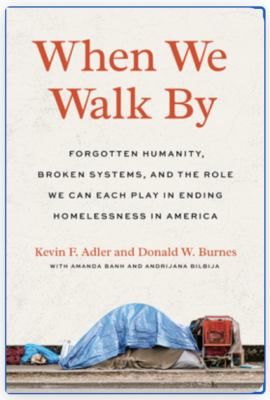When We Walk By – Kevin Adler

Exclusion presumes unbelonging, but there is no Planet Homelessness from where our neighbors experiencing homelessness emerged. Homelessness is a homegrown problem. Most of our unhoused neighbors were once our housed neighbors — and family members, classmates and friends. It’s long past time that we start treating them as such.
This book was left on my porch by my friend and neighbor Cardie. She follows the work of the Homelessness Task Force here in Fairfax City, which we work to give as much visibility as possible. One of the suggestions at the end of this book is to gift this book to someone else. That’s a great suggestion in moving forward a conversation addressing homelessness “not as a problem to be solved, but as people to be loved.”
What you will find here is individual stories, research, statistics, data, and public policies gathered from around the country. We can see with our own eyes the increase in people who are living unhoused in our community, and yet that is the tip of a very large iceberg that includes so many families, children, and others who are invisible among people in this country without stable housing. We generally see chronically unhoused single men as the face of this issue.
Yet the number of children and youth who experience homelessness is enormous. And the trauma this causes becomes one of the factors that often makes finding stable housing a challenge into adulthood.
Tragically, “the back door of the foster care system is the front door of the homeless system,” as the National Center for Housing and Child Welfare states. A staggering 36% of young adults who age out of the foster care system report experiencing homelessness by the time they are 26 years old. […] the next time you hear someone talk about homelessness as “a choice” or even more derogatory terms, consider asking if they believe that the more than one in three young people who age out of foster care into homelessness are somehow making a choice or are otherwise “failed” individuals.
There are so many factors that contribute to who ends up without housing. Some of them are not a surprise but well known to us – the investment in building prisons instead of affordable housing; the closing of mental health facilities to better integrate people living with mental health issues into our community – without ever building that housing in our communities.
One factor that was a surprise to me was a cancer diagnosis. Two women profiled in this book, Jennifer and Elizabeth, both ended up going through chemotherapy and recovery in a homeless shelter. One with a brand new baby. This is not as uncommon as we might think.
Housing insecurity and even homelessness are such common outcomes of a cancer diagnosis that there is even a term for it: “cancer-related financial toxicity.” According to a 2017 study, “between 20% and 30% of women diagnosed with breast cancer will lose their jobs, with poor women four times more likely to become jobless after a breast cancer diagnosis than their wealthier peers.”
I highly recommend this book. We need to think differently about how to change the outcomes for people who struggle against the factors that lead to being unhoused. There are so many. And each individual’s story is exactly that – their individual story. We have to get at the root causes of instability while simultaneously building housing that meets the needs of people in a variety of situations. We can create communities where more people thrive and are successful. We need to change how we think about it, talk about it and create public policy around that goal.